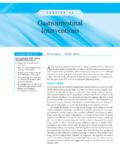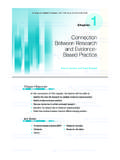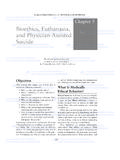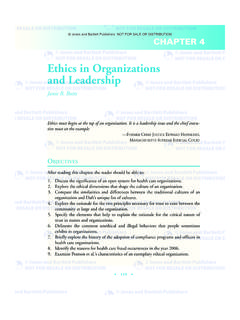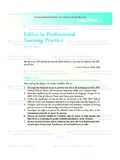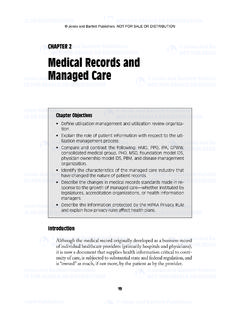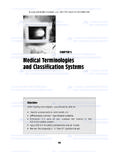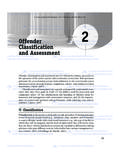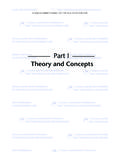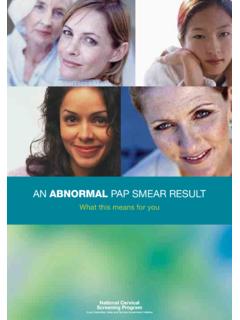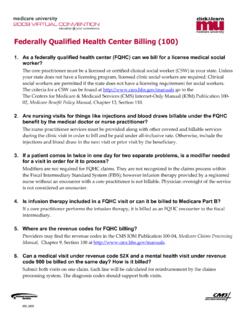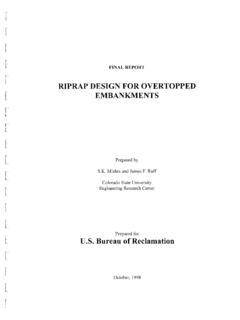Transcription of chapter 4
1 C h a p t e r 4 Theory Essence SentencePersonal beliefs influence health u d e n t Le a r n i n g Ou t cO m eSAfter reading this chapter the student will be able to:Explain the original concept of the Health Belief Discuss how the constructs of perceived seriousness, 2. susceptibility, benefits, and barriers might predict health the impact of the modifying variables on 3. health cues to action and how they motivate Use the theory to explain at least one ThEorETicAl concEpTThe Health Belief Model (HBM) is by far the most commonly used theory in health education and health promotion (Glanz, Rimer, & Lewis, 2002; National Cancer Institute [NCI], 2003). It was developed in the 1950s as a way to explain why medical screening programs offered by the Public Health Service, particularly for tuberculosis, were not very successful (Hoch-baum, 1958).
2 The underlying concept of the original HBM is that health behavior is determined by personal beliefs or percep-tions about a disease and the strategies available to decrease its occurrence (Hochbaum, 1958). Personal perception is influ-enced by the whole range of intrapersonal factors affecting health behavior, as discussed in chapter conSTrucTSThe following four perceptions serve as the main constructs of the model: perceived seriousness, perceived susceptibil-ity, perceived benefits, and perceived barriers. Each of these perceptions, individually or in combination, can be used to explain health behavior. More recently, other constructs have been added to the HBM; thus, the model has been expanded to include cues to action, motivating factors, and SeriousnessThe construct of perceived seriousness speaks to an indi-vidual s belief about the seriousness or severity of a disease.
3 While the perception of seriousness is often based on medical information or knowledge, it may also come from beliefs a person has about the difficulties a disease would create or the effects it would have on his or her life in general (McCormick-Brown, 1999). For example, most of us view the flu as a rela-tively minor ailment. We get it, stay home a few days, and get better. However, if you have asthma, contracting the flu could land you in the hospital. In this case, your perception of the flu might be that it is a serious disease. Or, if you are self-employed, having the flu might mean a week or more of lost wages. Again, this would influence your perception of the seriousness of this Belief 316/4/08 4:14:28 PM Jones and Bartlett Publishers, LLC.
4 NOT FOR SALE OR Belief Model32ant CJD, like BSE, affects the brain, causing tiny holes that make it appear spongelike. Both diseases are untreatable and fatal (National Institute of Neurological Disorders and Stroke, 2007). The perception of threat of contracting this disease through eating beef was one factor related to declining meat consumption in Germany (Weitkunat et al., 2003). People changed their behavior based on the perception of threat of a fatal example in which perception of threat is linked to behavior change is found in colon cancer survivors. Col-orectal cancer is a very serious disease with a high risk of recurrence. It is the perception of the threat of recurrence that increases the likelihood of behavior change in people previ-ously treated for this disease.
5 In particular, changes occur in their diets, exercise, and weight (Mullens et al., 2003).We see the same thing when people perceive a threat of developing non-insulin-dependent diabetes mellitus (NIDDM). Among people whose parents had or have the dis-ease, the perception of threat of developing it themselves is predictive of more health-enhancing, risk-reducing behaviors. Most important, they are more likely than others to engage in behaviors to control their weight (Forsyth, 1997), given that obesity is a known risk factor for as perception of increased susceptibility does not always lead to behavior change, as we saw earlier in the chapter with college students, neither does a perception of increased threat.
6 This is the scenario with older adults and safe food-handling behaviors. Older adults are among the groups most vulnerable to foodborne illness (Gerba, Row, & Haas, 1996) and are among those for whom it can be particularly serious. Even though they perceive a threat of illness from foodborne sources, they still do not use safe food-handling practices (Hanson & Benedict, 2002) all of the BenefitsThe construct of perceived benefits is a person s opinion of the value or usefulness of a new behavior in decreasing the risk of developing a disease. People tend to adopt healthier behaviors when they believe the new behavior will decrease their chances of developing a disease.
7 Would people strive to eat five servings of fruits and vegetables a day if they didn t believe it was beneficial? Would people quit smoking if they didn t believe it was better for their health? Would people use sunscreen if they didn t believe it worked? Probably benefits play an important role in the adop-tion of secondary prevention behaviors, such as screenings. A good example of this is screening for colon cancer. One of the screening tests for colon cancer is a colonoscopy. It requires a few days of preparation prior to the procedure to completely perceived SusceptibilityPersonal risk or susceptibility is one of the more powerful perceptions in prompting people to adopt healthier behav-iors.
8 The greater the perceived risk, the greater the likeli-hood of engaging in behaviors to decrease the risk. This is what prompts men who have sex with men to be vaccinated against hepatitis B (de Wit et al., 2005) and to use condoms in an effort to decrease susceptibility to HIV infection (Belcher et al., 2005). Perceived susceptibility motivates people to be vaccinated for influenza (Chen et al., 2007), to use sunscreen to prevent skin cancer, and to floss their teeth to prevent gum disease and tooth is only logical that when people believe they are at risk for a disease, they will be more likely to do something to prevent it from happening. Unfortunately, the opposite also occurs.
9 When people believe they are not at risk or have a low risk of susceptibility, unhealthy behaviors tend to result. This is exactly what has been found with older adults and HIV prevention behavior. Because older adults generally do not perceive themselves to be at risk for HIV infection, many do not practice safer sex (Rose, 1995; Maes & Louis, 2003). This same scenario was found with Asian American college stu-dents. They tended to view the HIV/AIDS epidemic as a non-Asian problem; thus, their perception of susceptibility to HIV infection was low and not associated with practicing safer sex behaviors (Yep, 1993).What we have seen so far is that a perception of increased susceptibility or risk is linked to healthier behaviors, and decreased susceptibility to unhealthy behaviors.
10 However, this is not always the case. In college students, perception of sus-ceptibility is rarely linked to the adoption of healthier behav-iors (Courtenay, 1998), even when the perception of risk is high. For example, although college students consider them-selves at risk for HIV because of their unsafe sex behaviors, they still do not practice safer sex (Lewis & Malow, 1997), nor do they stop tanning even though they perceive themselves to be at increased risk for skin cancer (Lamanna, 2004). Percep-tion of susceptibility explains behavior in some situations, but not the perception of susceptibility is combined with seriousness, it results in perceived threat (Stretcher & Rosen-stock, 1997).
